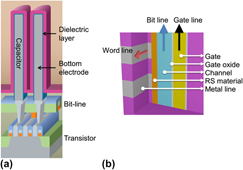Crossref Citations
This article has been cited by the following publications. This list is generated based on data provided by
Crossref.
Hudec, Boris
Hušeková, Kristína
Rosová, Alica
Šoltýs, Ján
Rammula, Raul
Kasikov, Aarne
Uustare, Teet
Mičušík, Matej
Omastová, Mária
Aarik, Jaan
and
Fröhlich, Karol
2013.
Impact of plasma treatment on electrical properties of TiO2/RuO2based DRAM capacitor.
Journal of Physics D: Applied Physics,
Vol. 46,
Issue. 38,
p.
385304.
Zhang, Lu
Chen, Zhijie
Joshua Yang, J.
Wysocki, Bryant
McDonald, Nathan
and
Chen, Yiran
2013.
A compact modeling of TiO2-TiO2–x memristor.
Applied Physics Letters,
Vol. 102,
Issue. 15,
Hu, Chengqing
McDaniel, Martin D.
Ekerdt, John G.
and
Yu, Edward T.
2013.
High ON/OFF Ratio and Quantized Conductance in Resistive Switching of ${\rm TiO}_{2}$ on Silicon.
IEEE Electron Device Letters,
Vol. 34,
Issue. 11,
p.
1385.
Acharyya, D
Hazra, A
Dutta, K
Gupta, R K
and
Bhattacharyya, P
2013.
Highly repeatable multilevel resistive switching characteristics of an Au/TiO2/Ti memory device.
Semiconductor Science and Technology,
Vol. 28,
Issue. 12,
p.
125001.
Aarik, Jaan
Arroval, Tõnis
Aarik, Lauri
Rammula, Raul
Kasikov, Aarne
Mändar, Hugo
Hudec, Boris
Hušeková, Kristina
and
Fröhlich, Karol
2013.
Atomic layer deposition of rutile-phase TiO2 on RuO2 from TiCl4 and O3: Growth of high-permittivity dielectrics with low leakage current.
Journal of Crystal Growth,
Vol. 382,
Issue. ,
p.
61.
Gong, Changjie
Ou, Xin
Xu, Bo
Lan, Xuexin
Lei, Yan
Lu, Jianxin
Chen, Yan
Yin, Jiang
Xia, Yidong
Liu, Zhiguo
Li, Aidong
and
Yan, Feng
2014.
Enhanced charge storage performance in AlTi4Ox/Al2O3multilayer charge trapping memory devices.
Japanese Journal of Applied Physics,
Vol. 53,
Issue. 8S3,
p.
08NG02.
Hu, Chengqing
McDaniel, Martin D.
Posadas, Agham
Demkov, Alexander A.
Ekerdt, John G.
and
Yu, Edward T.
2014.
Highly Controllable and Stable Quantized Conductance and Resistive Switching Mechanism in Single-Crystal TiO2 Resistive Memory on Silicon.
Nano Letters,
Vol. 14,
Issue. 8,
p.
4360.
Valov, Ilia
2014.
Redox‐Based Resistive Switching Memories (ReRAMs): Electrochemical Systems at the Atomic Scale.
ChemElectroChem,
Vol. 1,
Issue. 1,
p.
26.
Kaipio, Mikko
Blanquart, Timothee
Tomczak, Yoann
Niinistö, Jaakko
Gavagnin, Marco
Longo, Valentino
Wanzenböck, Heinz D.
Pallem, Venkateswara R.
Dussarrat, Christian
Puukilainen, Esa
Ritala, Mikko
and
Leskelä, Markku
2014.
Atomic Layer Deposition, Characterization, and Growth Mechanistic Studies of TiO2 Thin Films.
Langmuir,
Vol. 30,
Issue. 25,
p.
7395.
Park, Ji-Yoon
Yeo, Seungmin
Cheon, Taehoon
Kim, Soo-Hyun
Kim, Min-Kyu
Kim, Hyungjun
Hong, Tae Eun
and
Lee, Do-Joong
2014.
Growth of highly conformal ruthenium-oxide thin films with enhanced nucleation by atomic layer deposition.
Journal of Alloys and Compounds,
Vol. 610,
Issue. ,
p.
529.
Acharyya, D.
Hazra, A.
and
Bhattacharyya, P.
2014.
A journey towards reliability improvement of TiO2 based Resistive Random Access Memory: A review.
Microelectronics Reliability,
Vol. 54,
Issue. 3,
p.
541.
Fullam, S.
Ray, N.J.
and
Karpov, E.G.
2015.
Cyclic resistive switching effect in plasma electrolytically oxidized mesoporous Pt/TiO2 structures.
Superlattices and Microstructures,
Vol. 82,
Issue. ,
p.
378.
Kärkkänen, Irina
Shkabko, Andrey
Heikkilä, Mikko
Vehkamäki, Marko
Niinistö, Jaakko
Aslam, Nabeel
Meuffels, Paul
Ritala, Mikko
Leskelä, Markku
Waser, Rainer
and
Hoffmann‐Eifert, Susanne
2015.
Impedance spectroscopy study of the unipolar and bipolar resistive switching states of atomic layer deposited polycrystalline ZrO2 thin films.
physica status solidi (a),
Vol. 212,
Issue. 4,
p.
751.
Cao, Yuyuan
Di, Qitao
Zhu, Lin
Li, Aidong
and
Wu, Di
2015.
Resistive Switching Characteristics in TiO2/LaAlO3Heterostructures Sandwiched in Pt Electrodes.
Advances in Materials Science and Engineering,
Vol. 2015,
Issue. ,
p.
1.
Lee, Woongkyu
Yoo, Sijung
Jeon, Woojin
Yoo, Yeon Woo
An, Cheol Hyun
Chung, Min Jung
Kim, Han Joon
Lee, Sang Woon
and
Hwang, Cheol Seong
2015.
Reducing the nano-scale defect formation of atomic-layer-deposited SrTiO3 films by adjusting the cooling rate of the crystallization annealing of the seed layer.
Thin Solid Films,
Vol. 589,
Issue. ,
p.
723.
Arroval, Tõnis
Aarik, Lauri
Rammula, Raul
Kruusla, Vegard
and
Aarik, Jaan
2016.
Effect of substrate-enhanced and inhibited growth on atomic layer deposition and properties of aluminum–titanium oxide films.
Thin Solid Films,
Vol. 600,
Issue. ,
p.
119.
Kim, Doyeong
Lee, Minji
Song, Seung-Yub
Kim, Dae Hyun
Park, Tae Joo
and
Cho, Deok-Yong
2016.
Observation of Titania and Titanate Phase Changes in Oxidation-Controlled ZnO/TiN and HfO2/TiN Thin Films: An X-ray Absorption Spectroscopy Study.
The Journal of Physical Chemistry C,
Vol. 120,
Issue. 33,
p.
18674.
Agashe, Kirti
Sarwade, Nisha
Joshi, Sangeeta
Thakurdesai, Madhavi
and
Tirmali, Pravin
2016.
Effect of plasma growth temperature on resistive switching behavior of Pt/TiO<inf>2</inf>/n+Si ReRAM.
p.
1.
Valov, Ilia
and
Waser, Rainer
2016.
Resistive Switching.
p.
253.
Lucier, Bryan E.G.
and
Huang, Yining
2016.
Vol. 88,
Issue. ,
p.
1.
